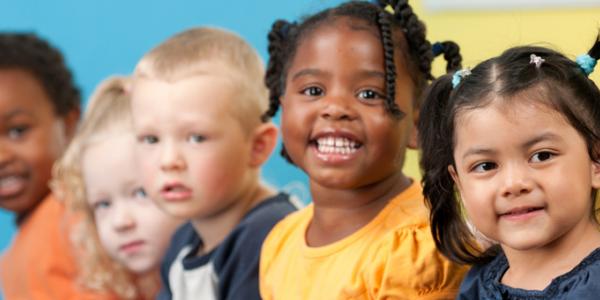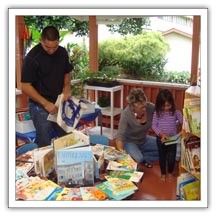Planning for Positive Guidance: Powerful Interactions Make a Difference

You are here
Guiding children’s behavior is something done throughout the day, not just when a child acts in a way that is unsafe or unacceptable. You guide behavior by establishing predictable routines, setting clear rules with children, and modeling kindness and respect. You are also attentive and aware of what is going on. Together, these actions help children feel noticed, confident, and secure. Children experience your attention and guidance as a caring embrace holding everything together. They know you’re on their team. (Dombro, Jablon, & Stetson 2011, 58)
This excerpt shapes our thinking as we plan for positive guidance in our classroom at a preschool in Pahoa, Hawaii. Using the three steps of a Powerful Interaction—Be Present, Connect, and Extend Learning—helps us be more successful at building strong, caring relationships with children and families. Powerful Interactions are interactions in which a teacher intentionally connects with a child to extend his or her learning. We also actively plan for guidance, which keeps a positive climate in our classroom. This boosts how we feel at the end of the day and enhances each child’s success as a learner.
Here are some strategies we use to plan for positive guidance, keeping a Powerful Interactions approach in mind.
Teamwork makes positive guidance more effective and Powerful Interactions possible!
It took time for us to become an effective teaching team. We had never worked together and had to become acquainted with each other’s teaching style. However, we wanted to be a seamless team because children tune in to their significant adults. We strive to coordinate our messages to children and make them clear and consistent. By staying present (step one of a Powerful Interaction) with each other and connected with our eyes, words, laughter, and other cues, we extend children’s learning during group times and transitions. Our teamwork has positive effects on children’s behavior and the classroom climate. It also gives us more energy to guide children in positive ways and enjoy each day. Three tips help us ensure seamless teamwork:
1. Be clear about roles. When we plan together, we clarify who will do what and when. Our goal is to be predictable about our roles during routines so that the children can anticipate what’s going to happen and who to look to for directions. This reduces challenging behaviors significantly. For example, at arrival time, Deborah greets children in our lending library and talks with them about books. At the same time, Danielle greets children and families at the classroom door and then moves around the room to support them as they do morning activities.
2. Make two voices one, literally and figuratively. This helps us deliver clear and cohesive messages to children. Too often children check with one adult and if they don’t like the answer, ask the other one. When children hear our voices from different areas of the room, they are more relaxed. We’re playful and sometimes silly about how we make our two voices one. We might echo each other’s voices melodically, complete each other’s sentences when giving directions, or finish each other’s rhymes. Danielle says, “There was one little bat in one big cave,” while looking over at Deborah who immediately chimes in, “He was so alone and not so brave.” The children enjoy the predictability of listening for our voices bouncing back and forth. Sometimes they look at the other adult to see what she’ll say.
3. Use frequent check-ins. We continually check in with each other throughout the day about what children are doing and how they are responding to activities and other children. We give each other signals about how things are going. The more we stay present, the easier it is to connect with each other. The result is a calmer classroom and fewer episodes of challenging behaviors. These tips have worked for us:
- Be on opposite sides of the room during indoor time to keep things running smoothly.
- Scan the room frequently, looking at what children are doing and at one another. Quickly read each other’s cues, such as a thumbs-up, smile, nod, or lift of an eyebrow.
- Update each other after an interaction with a child or family member. A quick summary or saying “Remind me to tell you about _____ later today” ensures consistency with each other, the children, and their families.
- Tune in to those children who need a little more attention. This can prevent challenging situations by catching them before they start.
Use daily arrival time to set the tone for positive guidance.
At the beginning of the year, teachers get to know children and their families through home visits and an orientation period (when a few children come for a few hours each day). During the orientation we introduce our arrival time routines. Our goal is for parents to have positive interactions with their children and for us to have Powerful Interactions with children and family members. Our routine and roles allow us to be present and connect with each child and her family for at least a few minutes. We plan activities that address positive guidance as well as language and literacy and math learning. When the day begins well, most children stay engaged and focused. Our predictable routine has three parts:
1. Offer specific activities in learning centers. We display simple written directions for activities parents and children can do together. While completing the activities is not required, parents and children often do them because they are engaging and they spark ideas to use at home.
2. Write an interactive morning message. The daily message is for families to read to their child as the child points to each word. Part of the message specifically relates to positive guidance. In Hawaiian culture and in our program, we emphasize the values of aloha (kindness), malama (caring), and kuleana (responsibility). To engage families and children in discussion, one question invites reflection about one of these three values. For example, the message might ask, What’s one way that you will show malama today? A family member helps the child answer the question, records his answer on a Post-it note, and adds it to a message chart that is on display for the week. Additional messages might ask, “How many letters are in your name?” or “Who brought you to school today?” We discuss the daily message when we gather for group time later in the morning.
3. Create a library. To encourage Powerful Interactions at home, we set up a lending library. Books are arranged in categories (that change periodically) so children can return their book in the morning and make a new selection. Children enjoy talking with Deborah about the books they return and hearing her recommendations for new selections.

Ensure smooth transitions.
As a team, we sustain a warm and friendly classroom climate by planning for and using teamwork to ensure smooth transitions. Over time we have established a repertoire of successful strategies in three main categories:
1. Humor. A light tone gives us energy and invites positive responses from children. Whether it is simply laughing aloud, making up a silly rhyme to give a direction, or singing funny words to a familiar song, we keep our transition times light and engaging. Sometimes we’re laughing at each other and our own silliness, which makes the children laugh, too.
2. Puppets. When we gather on the rug between activities, we each wear a finger puppet. The puppets talk about what will happen next, what they observed about cleanup, or the behaviors expected in the next activity. The children know these puppets well and seem completely invested in listening to them. Daisy: Hey Fuzzy, I used my walking feet when I came over to large group. Fuzzy: Me too. We know our kuleana (responsibilities), don’t we!
3. Music. Songs and melodies add to the positive climate. When interacting with one child at a time, we use natural, authentic voices. However, when we want to engage the whole group, we find that singing directions captures their attention more than our normal voices. These strategies work for us:
- Give verbal directions in a melodic voice.
- Use call-and-response or rhymes or something that allows voices to alternate. When we sing songs that have an echo pattern—like “Down by the Bay”—the children know to expect our voices to alternate.
- Give directions as lyrics to a familiar song and alternate voices. For example, as it gets close to cleanup, Deborah starts singing to Danielle to the tune of “If You’re Happy and You Know It.”
Deborah: Kumu (teacher) Danielle, are you ready to ring the chimes? (2x)
Danielle chimes in,
Yes I am and I’m walking over now
and I am ready to ring the chimes.
Deborah then begins the next verse as she guides the children in cleaning up, and Danielle moves toward the rug to help settle children.
Remember what to do when you hear the chimes . . . (2x)
We clean up our activity,
and walk over to our name,
and sit right down and show Kumu Danielle that you’re ready.
We have shared the ways we plan for positive guidance and use Powerful Interactions in our classroom to create a positive climate that prevents many challenging behaviors. The result is an enjoyable, effective, and productive learning environment. We hope you find the suggestions effective and that they spark more ideas for helping children and families.
Photo courtesy of the authors
Reference
Dombro, A.L., J. Jablon, & C. Stetson. 2011. Powerful Interactions: How to Connect with Children to Extend Their Learning. Washington, DC: NAEYC.
Judy Jablon is executive director of Leading for Children, a nonprofit organization focused on leadership in early learning, and author of numerous publications about early education.